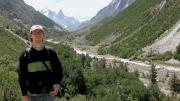In the summer of 2005, Anthony Acciavatti, M.Arch. ’09, and his local driver were in rural, north-central India, not far from the sacred city of Varanasi. They had stopped to watch the “soupy, brown water” of the Ganges River gush out of the mammoth, 1970s-era Narainpur Pump Canal system, which irrigates nearly 300 square miles of prime agricultural land. They followed the canal road until the driver suddenly refused to go any farther, saying the area was too dangerous.
Acciavatti, then a year out of the Rhode Island School of Design (RISD), left the car and walked ahead for a mile or so, to “see where the canal went.” Pausing to snap photographs, take notes, sketch, or keep an eye out for snakes, he hardly noticed three women approaching until, at about 12 feet away, “they whipped out machine guns and pointed them at me,” he recalls. “Aapka desh bahut sundar hai (Your country is very beautiful),” he blurted out in broken Hindi. The women asked if he was part of the government. No, he said, he was just studying the Ganges, and gestured to the canal. They gestured back, with their guns, toward the pumping station. Acciavatti turned around and fairly ran to the car, where he and the anxious driver both yammered “Chalo! Chalo! (Hurry!)”
“I have no way of knowing if those women were Naxal,” Acciavatti says, referring to members of the Communist guerrilla groups in India. “But they scared the bejesus out of me.” The young architect nevertheless stayed in India for the year, based at Allahabad University, to complete his Fulbright fellowship, and went on to make more than 15 additional solo trips between 2006 and 2014—traveling by foot, car, and boat—to map the upper portions of the Ganges River Basin.
The region is a fertile, alluvial plain that extends 1.1 million square kilometers and is fed by many rivers besides the dominant Ganges, which runs from the Gangotri Glacier in the Himalayas through northeastern India into Bangladesh before emptying into the Bay of Bengal. The enterprising mapmaker chose to focus on the thousand milesbetween the river’s source and Patna, a stretch with relatively few secondary streams. His initial goal was to capture the “fluid choreography” of the basin’s seasonal topographical changes in relationship to three conditions: population density, the monsoon, and agricultural demands. “It was an empirical project,” explains Acciavatti, who grew up in Decatur, Illinois, and has always been fascinated by rivers and agro-industrial systems. “I had never been to India before that first trip, and had no idea what I would find.” There were no recent maps of the area, and satellite and Google Earth imagery were at the time too vague or low-resolution: “I really had to just walk the land.”
His fieldwork—more than 25,000 photographs, 15 sketchbooks’ worth of drawings, 1,000 journal entries, and 350 original charts—became the first comprehensive survey of the region’s infrastructures, cities, and landscapes in 50 years, and is the subject of his new book, Ganges Water Machine: Designing New India’s Ancient River (2015). The project is “a huge, historical excavation,” notes Orchard professor in the history of landscape development John R. Stilgoe, Acciavatti’s thesis adviser. “That book would not exist if he had not gone to those places. Anthony has enormous courage—and physical courage does not come up much in the academy anymore.”
The Ganges rushes through mountainous tracts and critical animal habitats, including that of the endangered freshwater dolphin, and helps sustain 29 cities, like Varanasi, and hundreds of towns and villages. All told, the basin is home to at least a quarter of India’s 1.28 billion people who rely on the ice melt (which contributes about 10 or 15 percent of the river flow) and the more abundant monsoonal downpours for drinking water and crop irrigation. This water is particularly crucial to the northern state of Uttar Pradesh, where Acciavatti was based, and where nearly 20 percent of India’s grains are grown.
For Hindus, the Ganges is also a living goddess and the epicenter of spiritual life, even though it is also one of the most polluted natural resources in the world. A groundwater crisis exists, and pollution threatens food supplies and is linked to diseases like cholera and hepatitis. Previous efforts to clean up the waterway have failed. Acciavatti’s book, a technical tome geared to engineers, architects, environmentalists, and urban planners, is a potential guide to renewed restoration efforts by the government of India, funded through a $1.5-billion loan from the World Bank.
“Right now there is a lot of focus on what I call nineteenth-century hard infrastructure: channeling water into pipes treated as plumbing, building sewage-treatment plants that run on electricity in a context where electricity is not available 24 hours a day,” Acciavatti reports. His maps, on the other hand, lay a foundation for “soft infrastructure” solutions that are more sustainable environmentally and better integrate the cultural and practical ways people actually use the river basin. The maps, for example, include transects, visual cross-sections of the landscape that capture six “layers of the super-structure”—rivers, holding tanks and lakes, canals and drains, settlements, railways and roads, and tube-wells—and how they coexist and overlap, especially throughout the seasonal changes.
He is drawn to this “layering of the Ganges, both as a lifeline and a mosaic of sacred geographies.”
The six-foot-tall transects (reduced to fit into the book) chart the territory from the northern city of Allahabad and eastward to Varanasi, Acciavatti explains, and show how it would be possible to develop efficient wetlands and bioswales (landscape design features, such as pathways to drain and filter water), especially in less densely populated areas where sewage-treatment plants would be overkill. He envisions a system that would pay the subsistence farmers who live adjacent to the ineffective “nalahs,” or drains, where most raw waste enters the groundwater and the river, to transform their fields into wetlands and bioswales instead. Not only would the farmers earn more caring for this infrastructure than they make from their crops, Acciavatti says, but the system would cost far less than treatment plants and help decrease pollution from sewage and fertilizer runoff from farmlands.
About 65 percent of India’s rural population defecates outside, according to the World Health Organization, and that material accounts for at least 80 percent of the river’s pollution. That issue is not directly addressed in the book, he says, because the people he’s met, from villagers to academics to government officials, “cared more about access to water than water quality”; for them, especially if they are devout, “the river is always clean,” he adds. “I had people with Ph.D.s tell me there is no way you can get sick from drinking the water, because it is pure.”
He is drawn to this “layering of the Ganges, both as a lifeline and a mosaic of sacred geographies.” He first thought of mapping it while studying architecture at RISD. He had already spent a year in Rome (2002-2003) mapping the Tiber River and its influence on that city’s architecture and infrastructure, and as a freshman at Tulane (before transferring to RISD), his class projects had often focused on water management along the Mississippi. But he never expected, when he received a Fulbright, that his Ganges research would last more than a year—much less take him through Harvard and then on to Princeton, where he is finishing his dissertation on nation-building in Indian villages during the Cold War and expects to receive his doctorate in the history of science in June. (He is also an adjunct professor at Columbia’s school of architecture and runs a Manhattan design firm, Somatic Collaborative, with Felipe Correa, M.A.U. ’03, an associate professor of urban design at the Graduate School of Design.)
As Stilgoe notes, Acciavatti “is more of a polymath than most design students, and has a much greater regard for the history of what’s already on the ground.” His master’s thesis focused primarily on how his own hometown was transformed during the latter half of the twentieth century into an agro-industrial complex as part of the push to cultivate and process soybeans “for animal feed, and eventually, into materials for plastics and imitation meats,” Acciavatti says. Growing up about six miles from the then-headquarters of the Archer Daniels Midland Company (now ADM, based in Chicago), he didn’t pass it every day, but he could smell it: “Acrid. Like McDonald’s French fries, but they also processed high-fructose corn syrup, so there were other smells mixed in.” When completed in 1939, Midland’s was world’s largest solvent-extraction plant; the company went on to develop crude soybean oil into hundreds of new products. (Acciavatti explores these endeavors elsewhere. A 2013 Cabinet magazine article, “Ingestion: The Pyschorheology of Everyday Life,” covered the development of early scientific methods for measuring “chew texture” in foods like soy protein. “It’s interesting to think about how you objectify subjective sensations in the mouth,” he says. He’s also contributed a chapter on the development of soy-based meats to a pending anthology, “New Materials: Their Social and Cultural Meanings,” edited by historian Amy E. Slaton of Drexel.)
Midland and other emerging agricultural companies, he explains, needed greater access to water (for processing) and railways (for distribution), so they and the municipalities affected hired architects and engineers to “reconfigure existing cities in the 1920s and 1930s: rivers were dammed, new lakes were constructed, and city grids were re-aligned to increase production,” Acciavatti explains. “In Decatur, the largest manmade lake was constructed for soy processing, but it was pitched to the community as a great lake and park. There was a coupling of municipal recreation with industrial infrastructure.”
Those large-scale agricultural ventures share similarities with the historic transformation of the Ganges River Basin into a “machine,” Acciavatti asserts. That began with the British-built Ganges Canal in 1854, which is still being extended and now encompasses multiple methods, public and private, to redirect, extract, and consume the river’s water. One urgent concern is the proliferation and overuse of private tube-wells. More than two million of these metal or plastic pipes, fueled by diesel or electricity, have been installed by individuals, especially since the 1980s, he reports, yet the system is unregulated and the water is not monitored or paid for. “If the Ganges groundwater crisis is to be reversed,” Acciavatti wrote last year in a New York Times op-ed, “the tube-well economy must be reformed.”
Trekking throughout the region, often for four to six days at a stretch, Acciavatti documented areas of tube-well saturation. He traveled light—a backpack, camera, hand-held GPS device, potable water, and pens and paper—and stayed with villagers, sleeping on straw mattresses or dung floors, or on the boats that carried him along canals, lakes, and tributaries. “People were always worried about getting robbed, and there were crocodiles,” he says, “so you don’t want to sleep on the banks if you don’t have to.” (His lifelong fear of snakes didn’t help.) He was amazed to learn that even in areas dubbed “rural,” “between the clusters of villages and mosaic of fields watered by canals and lift irrigation, there was not a single space not shaped by infrastructure,” he writes. “My photographs and drawings framed a volatile meeting of religious and cultural heritage, agricultural cultivation, and diffuse urban settlements—the whole supported by an elaborate system of hydrological and transportation infrastructures….that rivaled that of the most densely populated blocks of Manhattan or Tokyo.”
Acciavatti launched his book in Delhi in October, at the CMS Vatavaran Environment and Wildlife Film Festival and Forum. While there he also met with the secretary of the Ministry of Water Resources, River Development, and Ganga Rejuvenation. When asked for proposals to help clean up the river and basin, he reiterated the need to address tube-wells, encouraged the construction of several experimental wetlands and bioswales, and also suggested a campaign to educate government officials and basin residents about the links among the monsoons, infrastructure, and waste management. Having had similar meetings in the past with other Indian officials, World Bank representatives, and organizations long-invested in the future of the country’s water supply, though, he is not surprised that he has yet to hear back about those ideas.
Indian prime minister Narendra Modi, leader of the Hindu nationalist Bharatiya Janata Party, has vowed to clean up “Mother Ganges,” but little has been done since his election in 2014. The previous government, which initiated the project in 2010, also struggled to effect any changes. “To undertake a sustainable approach requires one to see beyond the next election cycle,” Acciavatti notes. “It took a long time to get the way it did, and it will take a long time to fix it.”
Within hours of arriving in Allahabad that first time in 2005, Acciavatti took a rickshaw ride to the Triveni Sangam—the confluence of the Ganges, Yamuna, and the mythical Sarasvati rivers, and one of four rotating sites of Kumbh Mela, the massive triennial Hindu pilgrimage. “The cerulean blue Yamuna River meets the kind of gray-brown Ganges—you can actually see the line,” he reports. “Hindus believe that when the gods were making the soma, the nectar of life, that’s one of the places it spilled. That this ever-changing line, something that is never fixed, is the most sacred site where Hindus come to bathe in the river to cleanse themselves of all sins, just blew my mind.” Now the question is, can humans save the river from themselves?










